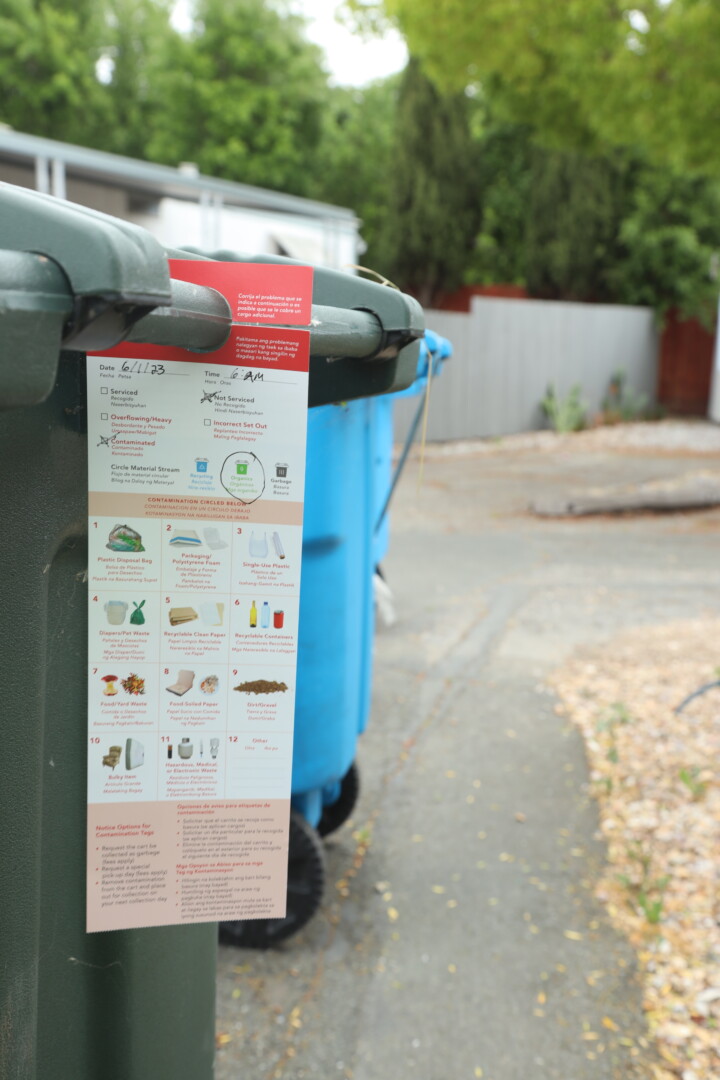Any items placed in the wrong containers are called contamination. For example, glass is not accepted in your compost container, liquids should not be placed in your recycling container, and food scraps do not belong in your garbage container.
Contamination can result in higher costs for processing materials and can cause your recyclable and compostable materials to unnecessarily be sent to the landfill. Apartment buildings that sort materials correctly into their recycling, composting, and trash bins qualify for a diversion discount. Learn more about diversion discounts.
To avoid contamination, review your sorting guides or watch our Waste Zero Training video (中文, Español).
| Collection Stream | Threshold for Contamination |
|---|---|
| Recycle | 10% |
| Compost | 5% |
| Trash | 25% |
Oops Tags

If we leave an “oops tag” on your container, it means the container tagged was contaminated with materials that belong elsewhere. Containers with ongoing contamination may be subject to contamination charges. We want to help you avoid contamination charges from being added to your account, so pay attention to the item we indicated on the tag.
We may also leave full containers on the day of your service because the contents were highly contaminated. If this occurs or if you have any other questions or concerns regarding your oops tag, please contact us.
Receiving a Contamination Charge
RESIDENTIAL- COMMERCIAL
Containers with contaminated material will be treated as garbage and sent to the landfill. All compost, recycling, and garbage containers will be subject to contamination charges and treated as garbage if the contents are contaminated. Contamination charges stack as follows:
-
-
-
- 1st Time: We will tag the container(s). No charges will be added to your account at this time.
- 2nd Time: We will tag the container(s). One-time Charges will be added to your account.
- 3rd Time: We will tag the container(s) and issue a warning letter to clean up the contamination within 30 days. If nothing changes, a 50% recurring contamination charge will be added to your account. Note: this charge will apply for a minimum of two billing cycles.
- 4th Time: Contamination charges may be increased from 50% up to 100% and/or loss of the monthly diversion discount.
-
-
How to Remove a 50% Contamination Charge
- To submit a request to remove contamination charges, you’re required to complete a self-assessment form.
- Complete the self-assessment form by downloading a printable form, or submit online using the links below:
- To print and mail your self-assessment form, use this printable PDF form: English PDF, Spanish PDF, Chinese PDF.
- If you choose to complete the self-assessment form online, use this link: English online form, Spanish online form, Chinese online form coming soon.
- Please contact us for more information on this process.
- For step-by-step instructions, check out our How to Conduct a Self-Assessment video.
Containers with contaminated material will be treated as garbage and sent to the landfill. All compost, recycling, and garbage containers will be subject to contamination charges and treated as garbage if the contents are contaminated. Contamination charges stack as follows:
-
-
- 1st Time: We will tag the container(s). No charges will be added to your account at this time.
- 2nd Time: We will tag the container(s). One-time Charges will be added to your account.
-